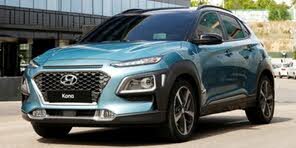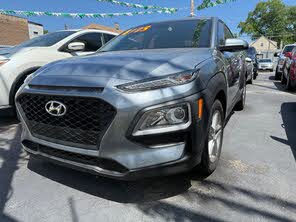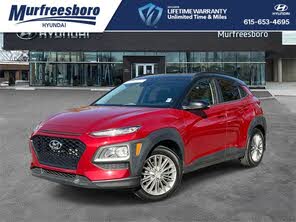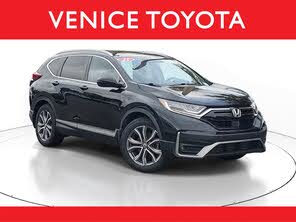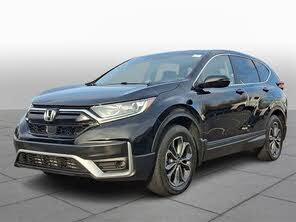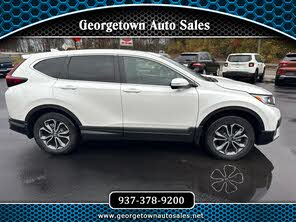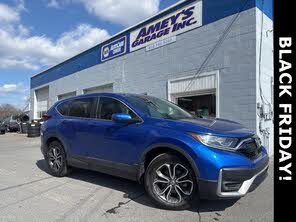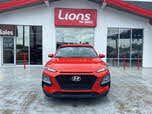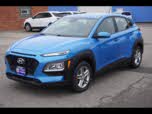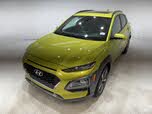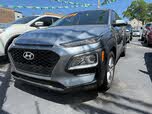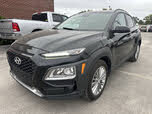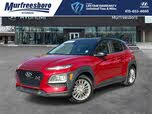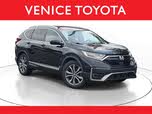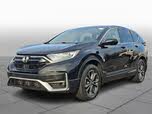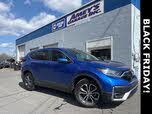2020 Hyundai Kona vs 2021 Honda CR-V
Overview | |
MSRP$20,300 | MSRP$25,350 |
Listings406 | Listings1266 |
Ratings & Reviews | |
User Reviews | User Reviews |
Expert reviews6.8 out of 10 | Expert reviews7.8 out of 10 |
Pros
Cons
| Pros
Cons
|
2020 Hyundai Kona Reviews SummaryThe Hyundai Kona subcompact SUV is one of the smallest cars you can buy with all-wheel drive. It competes in a class of four-door hatchbacks with the lifted suspensions and higher driving positions that crossover buyers want—and with the same generous list of convenience and safety features that come on larger crossovers. We last tested the Kona when it came out for 2018, but a new trim level and more standard driver assists are the major changes for 2020. For what Hyundai charges, the Kona is cramped and the interior disappoints, yet exterior style and on-road performance are spectacular. | |
2021 Honda CR-V Reviews SummaryEven in a grim year, Honda is selling a staggering number of CR-Vs. The CR-V is the best-selling Honda by far. It’s also the second best-selling compact SUV, just behind the Toyota RAV4. And it's the fifth best-selling vehicle in the U.S., and if you take out all the commercial sales of full-size pickups it’s one of the two best-selling vehicles year in and year out. So it’s hard to argue against the CR-V formula. Honda’s been at this almost as long as crossovers have been a thing, launching the CR-V in 1997—a year after the RAV4 debuted. The funny thing is, aside from sales volume, there’s only one thing the CR-V particularly excels at. Aesthetics are subjective, but it would be hard to argue the CR-V is the best looking vehicle in its class. It’s not the cheapest. It’s not the best equipped, especially at the middle to lower trim levels. It’s not the fastest, nor is it the quietest, or the most fuel efficient. It’s not even the most reliable, showing up nowhere in J.D. Power's Most Reliable list. So what makes it so appealing to American consumers? Let’s see if we can figure that out. | |
No video found | |
Popular Features & Specs | |
Engine2.0L 147 hp I4 | Engine1.5L 190 hp I4 |
Drive TrainFWD | Drive TrainFWD |
Seating Capacity5 | Seating Capacity5 |
Horsepower147 hp @ 6200 rpm | Horsepower190 hp @ 5600 rpm |
MPG City27 | MPG City28 |
MPG Highway33 | MPG Highway34 |
Engine | |
Engine Name2.0L 147 hp I4 | Engine Name1.5L 190 hp I4 |
Torque132 lb-ft @ 4500 rpm | Torque179 lb-ft @ 2000 rpm |
Horsepower147 hp @ 6200 rpm | Horsepower190 hp @ 5600 rpm |
DrivetrainFWD | DrivetrainFWD |
Fuel Economy | |
MPG City27 | MPG City28 |
MPG Highway33 | MPG Highway34 |
Interior | |
Seating Capacity5 | Seating Capacity5 |
Safety | |
Front Crash Overall5 | Front Crash Overall5 |
Side Crash Overall5 | Side Crash Overall5 |
Dimensions & Capacity | |
Cargo Space19.2 cu ft | Cargo Space39.2 cu ft |
Curb Weight2890 lbs | Curb Weight3337 lbs |
Height61.0 in | Height66.1 in |
Length164.0 in | Length182.1 in |
Width70.9 in | Width73.0 in |
Wheelbase102.4 in | Wheelbase104.8 in |
Maximum Payload1089 lbs | Maximum Payload1358 lbs |
Number of doors4 | Number of doors4 |
Maximum Towing Capacity | Maximum Towing Capacity1500 lbs |
Overview | ||
MSRP | $20,300 | $25,350 |
Listings | ||
Ratings & Reviews | ||
User reviews | ||
Expert reviews | 6.8 out of 10Read full review | 7.8 out of 10Read full review |
Pros & cons | Pros
Cons
| Pros
Cons
|
Summary | The Hyundai Kona subcompact SUV is one of the smallest cars you can buy with all-wheel drive. It competes in a class of four-door hatchbacks with the lifted suspensions and higher driving positions that crossover buyers want—and with the same generous list of convenience and safety features that come on larger crossovers. We last tested the Kona when it came out for 2018, but a new trim level and more standard driver assists are the major changes for 2020. For what Hyundai charges, the Kona is cramped and the interior disappoints, yet exterior style and on-road performance are spectacular. | Even in a grim year, Honda is selling a staggering number of CR-Vs. The CR-V is the best-selling Honda by far. It’s also the second best-selling compact SUV, just behind the Toyota RAV4. And it's the fifth best-selling vehicle in the U.S., and if you take out all the commercial sales of full-size pickups it’s one of the two best-selling vehicles year in and year out. So it’s hard to argue against the CR-V formula. Honda’s been at this almost as long as crossovers have been a thing, launching the CR-V in 1997—a year after the RAV4 debuted. The funny thing is, aside from sales volume, there’s only one thing the CR-V particularly excels at. Aesthetics are subjective, but it would be hard to argue the CR-V is the best looking vehicle in its class. It’s not the cheapest. It’s not the best equipped, especially at the middle to lower trim levels. It’s not the fastest, nor is it the quietest, or the most fuel efficient. It’s not even the most reliable, showing up nowhere in J.D. Power's Most Reliable list. So what makes it so appealing to American consumers? Let’s see if we can figure that out. |
Video | No video found | |
Popular Features & Specs | ||
Engine | 2.0L 147 hp I4 | 1.5L 190 hp I4 |
Drive Train | FWD | FWD |
Seating Capacity | 5 | 5 |
Horsepower | 147 hp @ 6200 rpm | 190 hp @ 5600 rpm |
MPG City | 27 | 28 |
MPG Highway | 33 | 34 |
Engine | ||
Engine Name | 2.0L 147 hp I4 | 1.5L 190 hp I4 |
Torque | 132 lb-ft @ 4500 rpm | 179 lb-ft @ 2000 rpm |
Horsepower | 147 hp @ 6200 rpm | 190 hp @ 5600 rpm |
Drivetrain | FWD | FWD |
Fuel Economy | ||
MPG City | 27 | 28 |
MPG Highway | 33 | 34 |
Interior | ||
Seating Capacity | 5 | 5 |
Safety | ||
Front Crash Overall | 5 | 5 |
Side Crash Overall | 5 | 5 |
Dimensions & Capacity | ||
Cargo Space | 19.2 cu ft | 39.2 cu ft |
Curb Weight | 2890 lbs | 3337 lbs |
Height | 61.0 in | 66.1 in |
Length | 164.0 in | 182.1 in |
Width | 70.9 in | 73.0 in |
Wheelbase | 102.4 in | 104.8 in |
Maximum Payload | 1089 lbs | 1358 lbs |
Number of doors | 4 | 4 |
Maximum Towing Capacity | 1500 lbs | |
The 2020 Hyundai Kona presented a striking and sporty exterior that set it apart from its competitors. Its design cleverly utilized its compact dimensions to create a sleek and dramatic appearance, making it visually appealing for a mass-market economy car. The Kona's exterior featured tiered lighting, a tall grille, and matte plastic trim, which gave it a taller and wider look. The car's design elements, such as slim LED running lamps and fender creases, contributed to its premium vibe. However, the interior of the Kona did not match the exterior's excitement, with hard plastics and lackluster finishes dominating the cabin. While the layout and screens were satisfactory, the overall tactile quality fell short compared to rivals like the Mazda CX-30 and Honda HR-V.
In contrast, the 2021 Honda CR-V had a more conventional design that blended in with other compact crossovers. Its styling was similar to many competitors, with few distinguishing features. The CR-V offered a range of colors, but most were shades of gray, black, or white, with limited vibrant options. Inside, the CR-V provided a modern look with angular seats and an upscale appearance in higher trims. While the CR-V's design was not its standout feature, it offered practicality and comfort, with a focus on functionality rather than aesthetics.










The 2020 Hyundai Kona surprised many with its impressive powertrain and chassis. Its 1.6-liter turbocharged inline-four engine delivered 175 horsepower and 195 pound-feet of torque, providing strong acceleration and confidence in various driving conditions. The 7-speed dual-clutch transmission complemented the engine's performance, offering quick responses and a satisfying driving experience. However, only the Limited and Ultimate trims featured the turbo engine, while the standard engine was a naturally-aspirated 2.0-liter inline-four with 147 horsepower. The Kona's handling was commendable, with fast steering and minimal body roll, making it enjoyable on twisty roads. Despite its performance strengths, the Kona's fuel economy was average for its class, with an EPA estimate of 26 mpg city and 29 mpg highway for the 1.6T AWD model.
The 2021 Honda CR-V offered a smooth and steady driving experience with its 190-horsepower turbocharged four-cylinder engine. While not designed for high-performance driving, the CR-V provided reliable acceleration and predictable cornering. All trims featured a continuously variable transmission (CVT), which prioritized efficiency over engagement. The CR-V's handling and ride quality were decent, with a MacPherson strut front suspension and multi-link rear suspension. The CR-V's fuel economy was competitive, with front-wheel drive as standard and all-wheel drive available as an option. Overall, the CR-V focused on delivering a comfortable and practical driving experience rather than sporty performance.
The 2020 Hyundai Kona struggled with interior space, offering limited cargo capacity compared to its competitors. With only 19 cubic feet of cargo space and 46 cubic feet with the rear seats folded, the Kona fell short in accommodating larger loads. While seating for four was adequate, the rear legroom was average, and taller passengers might find it cramped. The Kona's controls and infotainment system were user-friendly, but its utility as a crossover was limited by its compact size. It resembled a small hatchback more than a true crossover, lacking the versatility expected in this segment.
The 2021 Honda CR-V excelled in providing ample interior space and practicality. With 102.9 cubic feet of passenger volume and 75.8 cubic feet of cargo space with the rear seats folded, the CR-V offered generous room for passengers and their belongings. The CR-V's cargo area was easily accessible, with various tailgate options depending on the trim level. While roof rails were standard only on the top Touring trim, the CR-V's overall design prioritized functionality and comfort, making it a strong contender for families and those needing extra space.
The 2020 Hyundai Kona offered a range of standard features across its trims, with the base SE model including a 7-inch touchscreen with Apple CarPlay and Android Auto. Higher trims like the SEL and SEL Plus added features such as proximity entry, heated front seats, and a leather-wrapped steering wheel. The Limited trim introduced leather upholstery, while the Ultimate trim boasted an 8-inch touchscreen with navigation and adaptive cruise control. The Kona's technology package was comprehensive, with options for wireless charging and advanced connectivity through the Blue Link app.
The 2021 Honda CR-V provided a more basic technology offering in its base LX trim, featuring a 5-inch color screen with Bluetooth connectivity. However, higher trims included a 7-inch high-definition touchscreen with Apple CarPlay and Android Auto integration. The audio system improved with each trim level, culminating in a 300-watt system with a subwoofer in the Touring trim. The CR-V also offered multiple charging ports throughout the cabin, with wireless phone charging available in the Touring trim. While the CR-V's technology package was not as extensive as some competitors, it provided essential features for modern connectivity.
The 2020 Hyundai Kona received high safety ratings, earning five out of five stars overall from the NHTSA and a 2020 Top Safety Pick from the IIHS. It featured standard safety equipment such as forward emergency braking, lane-keep assist, and a driver attention monitor. However, pedestrian detection was only available on the Ultimate trim, and the Kona lacked front knee airbags and rear side airbags.
The 2021 Honda CR-V excelled in safety, earning both a five-star NHTSA rating and an IIHS Top Safety Pick award. While it did not achieve the highest IIHS Top Safety Pick+ rating due to headlight and side crash test scores, the CR-V's safety features were comprehensive. The Honda Sensing system, standard across all trims, included forward collision warning, lane departure warning, automatic emergency braking, and adaptive cruise control. The CR-V's commitment to safety made it a standout choice in its segment.
CarGurus highlights

According to CarGurus experts, the overall rating for the 2020 Hyundai Kona is 6.8 out of 10, while the 2021 Honda CR-V scores 7.8 out of 10. Based on these ratings, the 2021 Honda CR-V is the recommended choice, offering superior safety, interior space, and practicality for consumers seeking a reliable and family-friendly crossover.
Choose the 2020 Hyundai Kona if:
- You prioritize a sporty and visually appealing exterior design.
- You seek a turbocharged engine with strong performance in higher trims.
- You value a comprehensive technology package with advanced connectivity options.
Choose the 2021 Honda CR-V if:
- You need ample interior space and cargo capacity for passengers and gear.
- You prioritize safety with a comprehensive suite of standard features.
- You seek a comfortable and practical driving experience for everyday use.
CarGurus highlights

According to CarGurus experts, the overall rating for the 2020 Hyundai Kona is 6.8 out of 10, while the 2021 Honda CR-V scores 7.8 out of 10. Based on these ratings, the 2021 Honda CR-V is the recommended choice, offering superior safety, interior space, and practicality for consumers seeking a reliable and family-friendly crossover.
Choose the 2020 Hyundai Kona if:
Shop Now- You prioritize a sporty and visually appealing exterior design.
- You seek a turbocharged engine with strong performance in higher trims.
- You value a comprehensive technology package with advanced connectivity options.
Choose the 2021 Honda CR-V if:
Shop Now- You need ample interior space and cargo capacity for passengers and gear.
- You prioritize safety with a comprehensive suite of standard features.
- You seek a comfortable and practical driving experience for everyday use.

By: CarGurus + AI
At CarGurus, our team of experienced automotive writers remain at the heart of our content operation, conducting hands-on car tests and writing insightful guides that are backed by years of industry experience. To complement this, we are harnessing AI to make our content offering more diverse and more helpful to shoppers than ever. To achieve this, our AI systems are based exclusively on CarGurus content, ratings and data, so that what we produce is both unique to CarGurus, and uniquely helpful to car shoppers.




